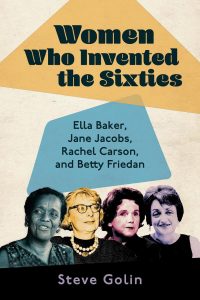Women Who Invented the Sixties
 Women Who Invented the Sixties (Jackson: University Press of Mississippi, 2022) by Steve Golin
Women Who Invented the Sixties (Jackson: University Press of Mississippi, 2022) by Steve Golin
The 1960s were a time of turmoil, reform, and tragedy. Pushed to their limits by social activism, political assassination, and massive military involvement in Southeast Asia, the American people often seemed to be in distress, both socially and politically. It was also marked by numerous urban riots. Violence often seemed normal. Nevertheless, there was also significant social progress. Steve Golin’s Women Who Invented the Sixties studies four of the decade’s most instrumental figures, Ella Baker, Jane Jacobs, Rachel Carson, and Betty Friedan. Baker is best known as a founder of a key civil rights organization, the Student Nonviolent Coordinating Committee (SNCC, 1960), and the others for iconic books, Jacobs, Death and Life of Great American Cities (1961), Carson, Silent Spring (1962), and Friedan, The Feminine Mystique (1963). Devoted to four areas in need of reform, race relations, urban planning, environmental protection, and women’s rights, these women rejected the passivity of the 1950s and “inaugurated a decade of radical thought and action.”
Golin divides his study into three separate sections. The first explores his subjects’ personal backgrounds and experiences during the 1950s, and then describes “their manifestations” in the early 1960s and concludes with “their consequences” in the late 1960s. The author’s point is that each person “intervened” to impart activism, and they did so starting out from decidedly different backgrounds. Baker, a Black Virginian who attended college in North Carolina, moved to Harlem and became a national leader of the NAACP, raised money to support the Montgomery Bus Boycott of 1955-56, and founded SNCC. Jacobs was raised in Scranton, Pennsylvania, and then resided in New York City, where she discovered how unchecked urban renewal could destroy a community, Greenwich Village. Carson came from western Pennsylvania but observed the destruction of lands around her by industrial pollution and campaigned against the use of the pesticide DDT, beginning on Long Island. An active supporter of the labor movement, Friedan focused on women’s rights and founded the National Organization for Women.
What Golin presents are insights into his subjects as distinct personalities. He regards Ella Baker as a civil rights leader, with perhaps less charisma than others, but more of a listener and organizer. Though subject to criticism from others in the civil right movement, to the author she was an “activists’ activist.” A “genteel subversive” who loved nature, Carson abhorred selfishness among people, especially those engaged in commerce, which she viewed, as in Golin’s words, as “merciless,” who “were fully capable of destroying the caves and shore.” Similarly, Jacobs took delight in challenging overreach, especially by Robert Moses in New York City. Betty Friedan wanted women to move out of the kitchen while coping with capitalism, of which she could be critical. According to Golin, she viewed “big business as the enemy of women workers.”
These women were activists and achievers with very different personalities, and his sketches of them are fascinating and more interpretative rather than detailed. In addition, he acknowledges other women, such as Dolores Huerta and Diane Nash, who also “remade America.” Yet his aim is not to present “a history of the civil rights, women’s or environmental movements,” but [to] add to our understanding of such situations as Rosa Parks and the Montgomery Boycott and Fannie Lou Hamer and the Mississippi Freedom Democratic Party’s challenge to the seating of delegates to the 1964 Democratic Party Convention at Atlantic City. As significant as these women were, Golin observes that they had much company. Like them, he notes, “millions of women entered history and changed its direction.” As “good listeners” who listened to each other and insisted “on their right to be equal with men, and to say what they saw, they challenged entrenched beliefs and institutions.” Viewed from this perspective Baker, Jacobs, Carson and Friedan served as role models for those who continue to challenge the status quo in the quest for a better world. In his thoughtful study, Golin gives them the credit they earned.
Reviewed by Robert D. Parmet, Professor of History, York College, The City University of New York
